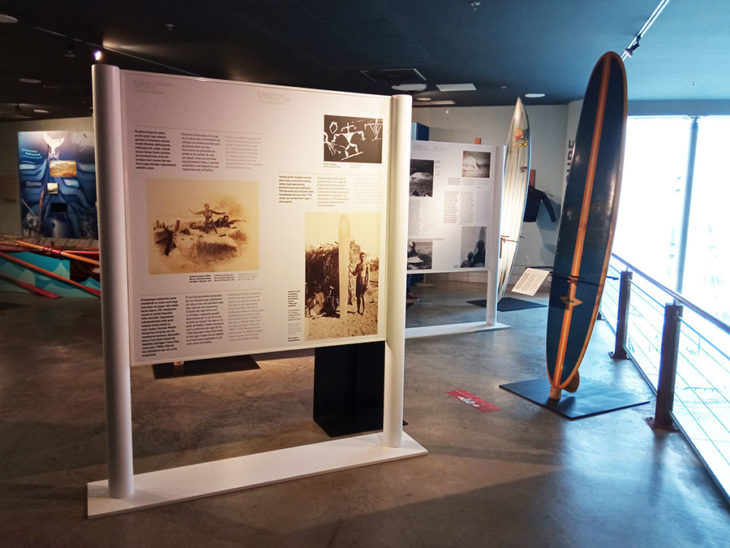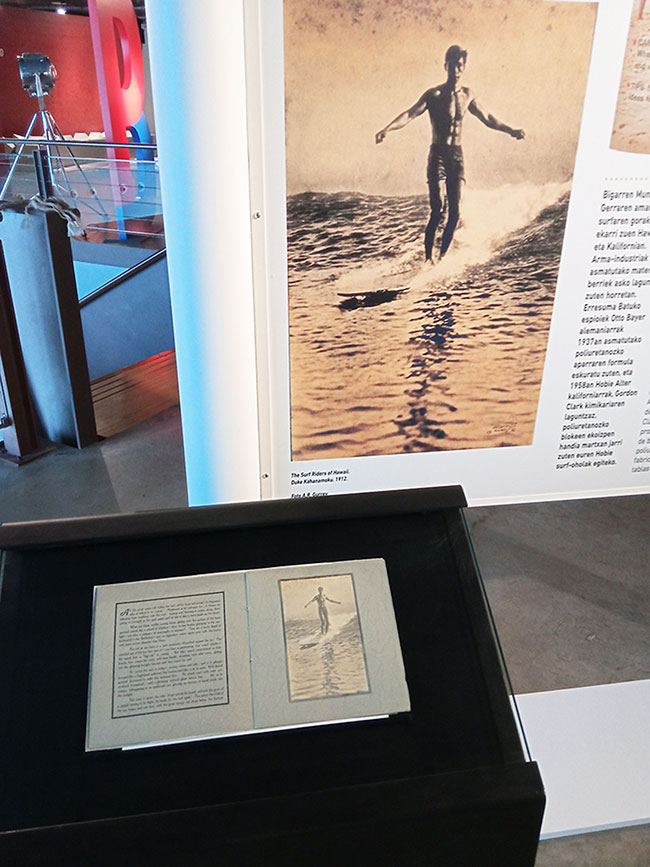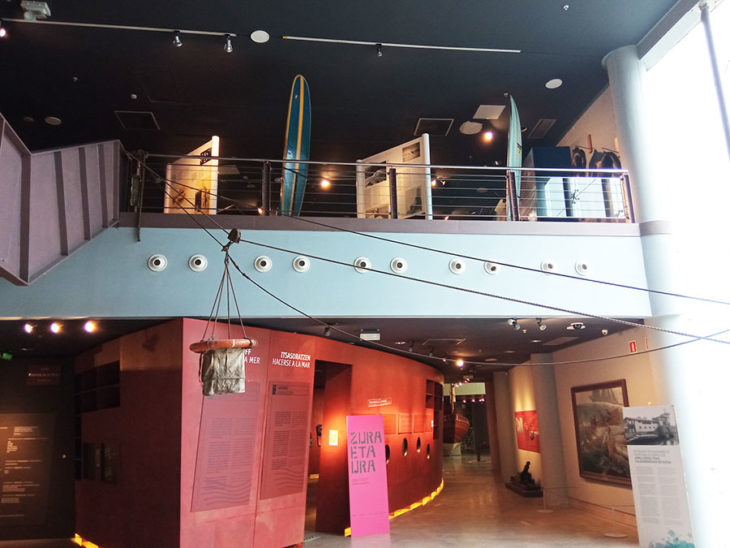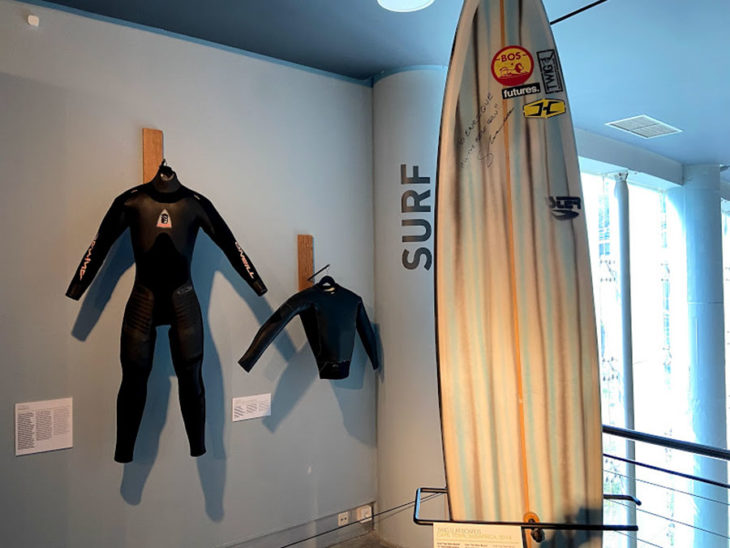Itsasmuseum presenta, dentro del proyecto de mejora de su exposición permanente recogido en el plan estratégico vigente, un nuevo espacio dedicado a la historia del surf, integrado en la zona de deportes y ocio, junto a la vela y el remo.
En esta zona se exponen cuatro paneles explicativos del origen del surf, su expansión, la entrada en Europa y la industria del surf en Euskadi, junto con algunos objetos representativos de esta historia, tres tablas de surf que representan tres momentos clave, un traje y una chaquetilla de surf de O’Neill, y el ejemplar de The Surf Riders of Hawaii, primer libro de surf de la historia y una de las 5 copias que quedan en el mundo.

Orígenes del surf. Aunque diversas civilizaciones en la humanidad han utilizado embarcaciones para deslizarse por las olas, fueron los polinesios los primeros en entenderlo como una actividad exclusivamente lúdica, los tahitianos los que en el siglo XII llevan el surf a Hawaii y fue durante la tercera expedición del explorador británico Capitán James Cook por el Pacífico, los primeros occidentales en descubrir las islas en 1778, cuando se registran las primeras referencias documentadas.
Durante la segunda década del siglo XIX, el surf fue censurado por las misiones que colonizaron las islas porque lo consideran una distracción para los nativos. En el siglo XX resurge en la playa de Waikiki. En 1908 Alexander Hume Ford fundó el primer club de deporte acuático que incluye el surf entre sus actividades e involucra al escritor estadounidense Jack London en la práctica del surf, quien se apasiona y escribe un artículo en “Women´s Home Companion”.
Dos imágenes ilustran esta sección, un grabado con surfistas, extraído del libro Sandwich Island Surf Riders de William Ellis (1831) y una fotografía de un surfista hawaiano posando delante de su cabaña en 1890.

La expansión. Con la llegada del turismo a Hawaii y gracias a la figura de Duke Kahanamoku, medalla de oro de natación en los Juegos Olímpicos de Estocolmo y uno de los mejores surfistas de Waikiki, el surf se expande a California y Australia.
Al final de la II Guerra Mundial llegan nuevos materiales provenientes de la industria armamentística, la inteligencia británica se hace con la espuma de poliuretano, inventada por Otto Bayer, en 1937, y en 1958 comienza la producción masiva de tablas Hobie construidas en poliuretano.
Mientras tanto, en California a inicios de los 50, Jack O´Neill comienza a experimentar con materiales aislantes para combatir el frio, una alfombrilla de neopreno en un avión le inspiró y empezó a producir trajes de surf de este material. Así en 1952 nace la marca de neoprenos O´Neill.

La entrada en Europa. Oficialmente se considera que el surf entra en Europa en 1957, un año antes un guionista californiano (Peter Viertel) que viaja a Biarritz para el rodaje de Fiesta, trae consigo su tabla de surf, y unos años después, el surf llegó a Euskadi. La revista Life sirve de inspiración al donostiarra Iñaki Arteche para construir su primera tabla y surfear en la Concha, junto con su hermano en 1964. Fueron los primeros en hacerlo y tras ellos el surf se extendió a Getxo con José Luis Elejoste y Carlos Pradera como pioneros y a otras playas de Euskadi.
En este apartado se hace una mención especial a la barra de Mundaka, que puso a Euskadi en el mapa del surf mundial y que empezó a surfearse entre los años 1967 y 1968.
Algunas imágenes de personas haciendo surf en Hendaia, de José Luis Elejoste en la playa, de la barra de Mundaka y de Catherine Deneuve en Biarritz en 1963 ilustran el contenido.

Industria vasca. En este punto se hace un recorrido por diferentes hitos de la industria del surf en Euskadi, en el que destaca Patxi Oliden que en 1970 crea Itxas Tresna en Orio, la primera marca que producía tablas para su comercialización. Después surgieron otras como Genesis Surfboards o Bong, ambas en Getxo.
En la década de los 80 surgen marcas autóctonas de neoprenos como Waterline o Seland en Getxo y en 1987 sale en Santurtzi el primer número de la revista Tres60 que aglutina e impulsa al sector.
Aunque ya había mujeres surfeando en la década de los 70, el surf femenino no coge fuerza hasta la década siguiente, momento en el que el crecimiento, tanto en número de mujeres que lo practican como a nivel competitivo, viene siendo exponencial.
En el campo de la innovación existen ejemplos de empresas locales como Wavegarden que, en 2005, crea una piscina de olas que aúna nuevas tecnologías e ingenierías punteras para crear olas artificiales, muy bien valoradas por los amantes del surf por su parecido con las olas reales.

Toda esta información viene acompañada de diversos objetos entre los que destacan tres tablas de surf, una tabla Hobie histórica de cuando comienzan a fabricarse con nuevos materiales y que data de 1958 en California, otra firmada por José Luis Elejoste del taller oriotarra Itxas Tresna y la tercera, es la tabla que utilizó el sudafricano Twiggy Baker, tricampeón mundial Big Wave Tour, cuando ganó el Punta Galea Challenge 2014/2015. Junto a estas tablas, también se exponen dos neoprenos, un traje del modelo “Animal” de O´Neill de 1991 que supuso un salto en la industria, por su calidad, materiales y costuras, y una chaquetilla corta, también de O´Neill de los años 60, pensada para surfear en verano, y que fue de José Luis Elejoste, pionero del surf en Bizkaia.
Completa la exposición un ejemplar de The Surf Riders of Hawaii, primer libro de surf de la historia que Ignacio Arana, apasionado del surf y cónsul en Hawaii entre 1911 hasta 1914, trajo consigo a Euskadi.
El diseño y la realización de esta nueva zona, se ha llevado a cabo junto a Surfing Challenge SL y ha contado con la colaboración de O´Neill, y la cesión de piezas y objetos por parte de Enrique Artero, Felip-Guillem Verger y la propia O’Neill.
Para saber más entra en: www.itsasmuseum.eus




English:
Itsasmuseum presents, as part of the project to improve its permanent exhibition included in the current strategic plan, a new space dedicated to the history of surfing, integrated in the sports and leisure area, next to sailing and rowing.
In this area there are four panels explaining the origin of surfing, its expansion, its entry into Europe and the surf industry in the Basque Country, together with some objects representative of this history, three surfboards representing three key moments, an O’Neill surfing suit and jacket, and a copy of The Surf Riders of Hawaii, the first surfing book in history and one of the 5 copies left in the world.
Origins of surfing. Although various civilisations in humanity have used boats to glide over the waves, it was the Polynesians who first understood it as an exclusively recreational activity, the Tahitians who in the 12th century brought surfing to Hawaii and it was during the third expedition of the British explorer Captain James Cook through the Pacific, the first Westerners to discover the islands in 1778, when the first documented references are recorded.
During the second decade of the 19th century, surfing was censored by the missions that colonised the islands because they considered it a distraction for the natives. In the 20th century it re-emerged on Waikiki Beach. In 1908, Alexander Hume Ford founded the first water sports club that included surfing among its activities and involved the American writer Jack London in surfing, who became passionate about it and wrote an article in “Women’s Home Companion”.
Two images illustrate this section, an engraving with surfers, taken from the book Sandwich Island Surf Riders by William Ellis (1831) and a photograph of a Hawaiian surfer posing in front of his hut in 1890.
Expansion. With the arrival of tourism in Hawaii and thanks to the figure of Duke Kahanamoku, swimming gold medallist at the Stockholm Olympics and one of the best surfers in Waikiki, surfing spread to California and Australia.
At the end of World War II, new materials arrive from the arms industry, British intelligence gets hold of polyurethane foam, invented by Otto Bayer, in 1937, and in 1958 the mass production of Hobie boards made of polyurethane begins.
Meanwhile, in California in the early 50’s, Jack O’Neill began to experiment with insulating materials to combat the cold, a neoprene mat in an aeroplane inspired him and he began to produce surfing suits made of this material. In 1952, the O’Neill wetsuit brand was born.
The entry into Europe. Officially, surfing is considered to have entered Europe in 1957, a year before a Californian scriptwriter (Peter Viertel) who travelled to Biarritz for the filming of Fiesta, brought his surfboard with him, and a few years later, surfing arrived in the Basque Country. Life magazine inspired Iñaki Arteche from San Sebastian to build his first board and surf at La Concha, together with his brother in 1964. They were the first to do so and after them surfing spread to Getxo with José Luis Elejoste and Carlos Pradera as pioneers and to other beaches in the Basque Country.
In this section, special mention should be made of the Mundaka bar, which put the Basque Country on the world surfing map and which began to be surfed between 1967 and 1968.
Some images of people surfing in Hendaye, José Luis Elejoste on the beach, the Mundaka bar and Catherine Deneuve in Biarritz in 1963 illustrate the content.
Basque industry. This section takes a look at different milestones in the surfing industry in the Basque Country, in which Patxi Oliden stands out, who in 1970 created Itxas Tresna in Orio, the first brand to produce boards for commercialisation. Later, others such as Genesis Surfboards or Bong, both in Getxo, appeared.
In the 1980s, local wetsuit brands such as Waterline and Seland appeared in Getxo, and in 1987 the first issue of Tres60 magazine was published in Santurtzi, bringing together and promoting the sector.
Although there were already women surfing in the 70s, women’s surfing did not take off until the following decade, when the growth, both in terms of the number of women surfers and at a competitive level, was exponential.
In the field of innovation, there are examples of local companies such as Wavegarden which, in 2005, created a wave pool that combines new technologies and cutting-edge engineering to create artificial waves, highly valued by surf lovers for their resemblance to real waves.
All this information is accompanied by various objects, including three surfboards, a historic Hobie board from 1958 in California, another signed by José Luis Elejoste from the Itxas Tresna workshop in Orihuela and the third is the board used by the South African Twiggy Baker, three-time Big Wave Tour world champion, when he won the Punta Galea Challenge 2014/2015. Along with these boards, two wetsuits are also on display, an O’Neill “Animal” wetsuit from 1991, which represented a leap in the industry due to its quality, materials and seams, and a short jacket, also by O’Neill from the 60s, designed for surfing in summer, which belonged to José Luis Elejoste, a pioneer of surfing in Bizkaia.
The exhibition is completed with a copy of The Surf Riders of Hawaii, the first surfing book in history, which Ignacio Arana, a surfing enthusiast and consul in Hawaii between 1911 and 1914, brought with him to the Basque Country.
The design and creation of this new area has been carried out together with Surfing Challenge SL and has counted with the collaboration of O’Neill, and the transfer of pieces and objects by Enrique Artero, Felip-Guillem Verger and O’Neill herself.